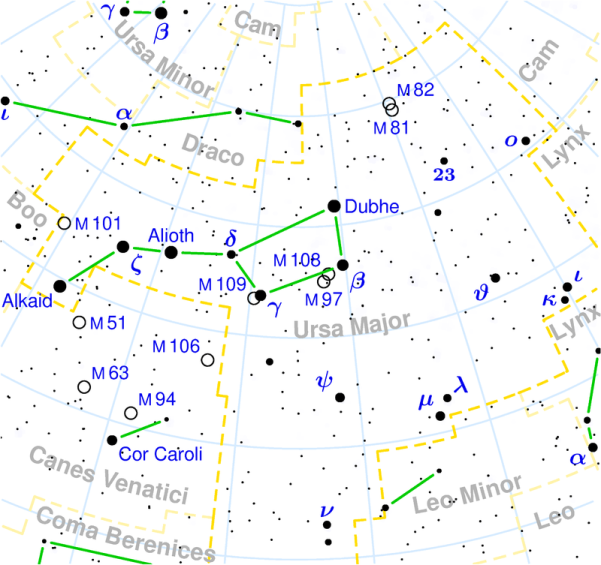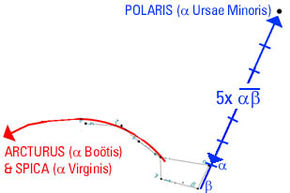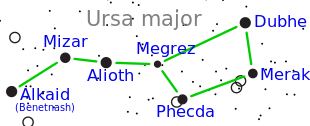

URSA MAJOR

The Great Bear (in Latin Ursa Major) is a typical constellation of the northern skies; its seven brightest stars, grouped in the famous asterism of the Big Dipper, are visible throughout the year in the northern hemisphere, and never set to the north of 41 ° N (latitude of Naples, Madrid and New York).
The reference to the asterism like a bear (the four Eastern Star) chased by three hunters (three in the queue) is probably the most ancient myth in which the still refers humanity. In other parts of the world are different names used in North America is the Big Dipper, in the United Kingdom is the Plow, Septem Triones, that is, the seven oxen, instead the term with which the ancient Romans called it the seven stars of Ursa Major, describing their slow motion around the pole star. Hence the origin of the north end, ie north.

The stars of the Big Dipper are called, in order from west to east, Dubhe, Merak, Phecda, Megrez, Alioth, Mizar and Alkaid (or Benetnasch), and have been assigned to them by the Greek letters α to η (see Nomenclature of Bayer ), in the same order. Mizar has a companion star called Alcor, barely visible to the naked eye. Both stars are in fact double, and have been, respectively, the first visual binary and the first spectroscopic binary discoveries. The North Star can be found by drawing a line between Dubhe and Merak, the extreme of the Big Dipper, and extending it by five times. Other stars like Arturo (α Boötis) and Spica (α Virginis) can be found instead of prolonging the long side.
In 1869, Richard. A. Proctor noted that, except for Dubhe and Alkaid, the stars of the Big Dipper all have the same proper motion, which leads to a common point of Sagittarius. This group, now known as the Ursa Major Moving Group (Cr 285), which have been identified as some other members, formed in the past an open cluster.
Since then cluster stars were scattered in a region of about 30 to 18 years light, located about 75 light-years away, which is therefore the closest object resembling a heap. More about 100 stars, including Sirius, form a "power" that has the same proper motion, but their relationship with the ex-clutter is unclear. Our solar system is located on the outer edge of this trend, but not part of it, having an age 40 times.
PRINCIPAL STARS

· α Ursae Majoris, known by the Arabic name Dubhe ("the bear"), which at a magnitude of 1.79 is the 35th brightest star in the sky and the second brightest of Ursa Major.
· β Ursae Majoris, called Merak ("the loins of the bear"), with a magnitude of 2.37.
· γ Ursae Majoris, known as either Phecda or Phad ("thigh"), with a magnitude of 2.44.
· δ Ursae Majoris, or Megrez, meaning "root of the tail," an appropriate name given its location as the intersection of the body and tail of the bear (or the ladle and handle of the dipper).
· ε Ursae Majoris, known as Alioth, a name which refers not to a bear but to a "black horse," the name corrupted from the original and mis-assigned to the similarly namedAlcor, the naked-eye binary companion of Mizar. Alioth is the brightest star of Ursa Major and the 33rd brightest in the sky, with a magnitude of 1.76. It is also the brightest of the "peculiar A (Ap) stars," magnetic stars whose chemical elements are either depleted or enhanced, and appear to change as the star rotates.
· ζ Ursae Majoris, Mizar, the second star in from the end of the handle of the Big Dipper, and the constellation's fourth brightest star. Mizar, which means "girdle," forms a famous double star, with its optical companion Alcor (80 Ursae Majoris), the two of which were termed the "horse and rider" by the Arabs. The ability to resolve the two stars with the naked eye is often quoted as a test of eyesight, although even people with quite poor eyesight can see the two stars.
· η Ursae Majoris, known as either Alkaid or Benetnash, both meaning the "end of the tail." With a magnitude of 1.85, Alkaid is the third-brightest star of Ursa Major.
Among other stars, it reports 47 Ursae Majoris, known to have a planetary system with three confirmed planets, 2.54 and 0.76 times the mass of Jupiter.
Lalande 21185 is the fourth closest star to the Earth (except the Sun).
DOUBLE STARS
The Big Dipper contains some double stars, although not many given the size of the constellation. Some of them are particularly popular, and easy to fix.
- Mizar is paired with Alcor: the two stars are so wide apart that you can solve them even to the naked eye; However Mizar is itself a double with components of second and third magnitude separated by 14 ", therefore, solvable with a telescope of small to medium size.
- Dubhe is a couple easy to melt, being formed by a star of the second and a seventh separated by some early, thus also solved with a pair of binoculars; the two components are in blue (the first) and whitish (the second).
- ι Ursae Majoris has the components of the third and tenth magnitude, with strongly contrasting colors (red and white) but only solved with relatively high magnifications; the difficulty of the resolution is also given by the largest of the two stars of magnitude difference.
The identification of the seven main stars with the figure of a bear is present in different and distant civilizations, and, not having any particular resemblance to this set of stars with the animal, a random cultural convergence is highly unlikely. The inhabitants of North America shared this myth before the arrival of European colonists, probably brought by the first humans who colonized the continent 14,000 years ago. Many scholars still consider this myth even older, to date back to Europe than thirty thousand years ago when, as different findings show, a cult of the bear was widespread. It was one of the 48 constellations listed by Ptolemy.
It was always one of the best known constellations, mentioned by poets like Homer, Edmund Spenser, Shakespeare, Leopardi and Alfred Tennyson. It is also the Finnish epic Kalevala, and was painted by Vincent van Gogh.
The Big Dipper, dear to the poet Gabriele d'Annunzio, is depicted in the emblem of the Italian Regency of the Kvarner and the coat of arms of the Province of Fiume.
MYTHOLOGY
In classical mythology, one of the companions of Artemis, Callisto, lost her virginity to Zeus, who had come in the guise of the same Artemis. Angry, Hera changed her into a bear. Callisto's son, Arcas, nearly killed his mother while he was hunting, but Zeus and Artemis stopped him and placed both in the sky as Ursa Major and Ursa Minor. Hera was not pleased with the fact that they had been taken into heaven, and therefore sought help from Teti. This, a marine goddess, turned to the constellations a curse because they were forced to run forever in circles in the sky, and do not ever rest below the horizon, thus explaining the fact that these constellations are circumpolar.
A variant of the myth is given by the Hellenistic poet Aratus in the preface of the phenomena: the two celestial bears would be the bears who held rescued Zeus child in a cave to hide his father Kronos who wanted to swallow him as he had done with his brothers.
On the contrary, the Tuareg, who do not know bears, see in it a camel, whose neck is extended up to reach Arturo (which is also included in the constellation). This camel would be the outcome of the transformation of the legendary camel Fakrou, killed by the wicked. The Ursa Minor would rather a small camel, kept tied to a stake around which will continue to operate (Polaris).
From this constellation also comes the term north, as for the Romans the current constellation of Ursa Major was also known as "the Septem Triones" (seven draft oxen), hence the term to indicate the North.
